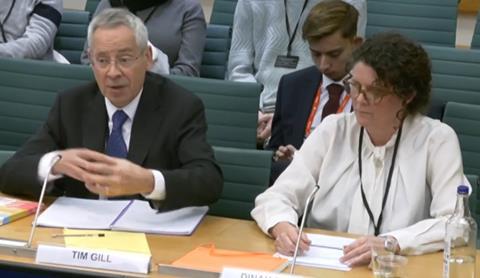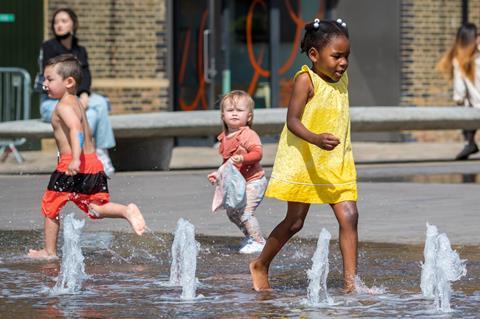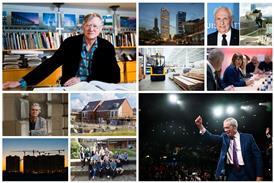Only 6% of housing developments involve architects, parliamentary inquiry into young people and the built environment is told
The current planning and development system largely overlooks the needs of children and young people, a parliamentary inquiry was told yesterday.
The claim was made as MPs on the Levelling Up, Housing and Communities select committee heard further oral evidence in the inquiry into children, young people and the built environment.

Tim Gill, former director of the Children’s Play Council (now Play England), argued that, while play facilities were important to creating positive environments for children and young people, mobility was actually the critical issue in the built environment that needed to be addressed.
“The evidence about how you get more children out and active is pretty clear,” he said. “The two most important influencing factors on what makes neighbourhoods places where children can go out, spend time outdoors and play are mobility and transport.”
Gill went on to highlight the need to ensure that children could walk around their neighbourhoods, safe from the threat of traffic.
“The cities and countries that are most effective at getting neighbourhoods to work better for children really see children as a prism or lens through which to see the whole of the planning system,” he said.
“It’s a strategic question that is taken seriously, about how a focus on children makes concrete what good places look like – they’re walkable, they’re compact, they’re green. It also helps to build a long-term vision and consensus about what good places look and feel like.”
Dinah Bornat, co-director at ZCD Architects, explained how her practice had become interested in child-friendly design a decade ago. “The first thing we did, with the support of Homes England, was a piece of work looking at 10 housing estates across England,” she said.
Spaces that worked well not only worked for children, but also for adults
“Homes England were concerned with how their housing developments were performing and wanted to know whether the layouts of their developments were actually working from a social perspective.”
Her practice’s research was gathered through observational studies of how residents were using outdoor spaces. “The biggest finding was that spaces that worked well not only worked for children, but also for adults,” she said.
“When this worked well, there was one particular thing that was in place, and that was space outside your front or back door where you could just literally tumble out of your house and go and play and meet friends. That was the determining factor, and it’s what we call doorstep play.”

Jonny Anstead, founding director of TOWN and chair of the Quality of Life Foundation, couched his evidence within what he described as “a much wider quality issue that we have nationally”.
He referenced the 2020 Housing Design Audit for England by the Place Alliance, saying that it had found that “new housing development across the country was overwhelmingly mediocre or poor”. It identified a range of problems, including “design of highways, layout of bins and parking, a lack of character of place, including green spaces, design of streets and a lack of walkability”.
“It’s no coincidence,” Anstead said, “that those are all the same kind of issues that we’re talking about in determining whether a place is good or not for children.”
Very little is expected of us through the planning system, and we’re generally encouraged to think about the needs of children as a kind of tick-box activity
Responding to a question from the committee chair, Clive Betts MP, about the apparent difficulties that developers face in delivering quality environments, Anstead conceded that “it is definitely the case that developers find it difficult to build good urban environments full stop, including for children.
“From a developer’s perspective I think there is a problem in that very little is expected of us through the planning system, and we’re generally encouraged to think about the needs of children as a kind of tick-box activity.”
He argued that the current guidance reduced the needs of children to delivering discrete fenced play areas within developments. “That’s very convenient for developers in that it’s very cheap, it takes up very little space, you can buy it off the shelf and it’s very easy to incorporate into a standard housing development layout.
“It doesn’t require us to do anything different and it really falls short of what is required in terms of actual outcomes for children,” Anstead added.
“It doesn’t really do very much in terms of safety and mobility. The freedom to move around independently, to cultivate relationships with your peers from a young age, to grow in independence, and have your needs met in different ways as you progress through your childhood, are clearly not going to be met by a 3m by 3m playground with a ride-on toy.
“For those of us who do wish to do more, we hit real challenges,” Anstead explained. “The kinds of things that we’d be looking to do would be around reducing the dominance and impact of cars in a neighbourhood, creating safer streets where children can play, where there’s a sense of independence, where children have the ability to play out on the doorstep.”
He explained how objections to creating such developments sometimes stemmed from the perceived need to facilitate the collection of wheely bins, and highways engineers’ prioritisation of cars. “The path of least resistance is to create an environment that is very good for refuse and highways, but which is very poor for children,” he said.

Addressing the widely perceived poor quality of much new housing, Jo McCafferty, director at Levitt Bernstein, highlighted that only 6% of new homes in the UK are designed by architects. “You can see from that figure that the design professions and those with expertise are not really involved in those projects very much.
“There are examples of best practice, and we just need support to build more of those.”
Some of it doesn’t cost very much, it really is about attention to detail
She referenced how Levitt Bernstein had been working with 100 children from two local schools in Poplar on an estate to rethink how new development can work for children and young people.
“Some of it doesn’t cost very much, it really is about attention to detail… [such as] the position of a gate, or pairing of an entrance so that you can meet your neighbour and play out in the morning, while parents can watch on easily from the kitchen window.”
“Children understand that detail and they want to talk about it.”
Sarah Scannell, assistant director of planning at Birmingham City Council, said children were currently considered within local plans at “a very high level”, which focused on provision of school places and access to a GP. She said the planning system very rarely went into the detail and “qualitative assessment”.
She highlighted the need for improved consultation and engagement with young people, pointing out that there was currently “no requirement for a local authority to demonstrate that a certain number of people in any protected characteristic have commented or been engaged on local plan development”.
Scannell pointed out that demands placed on planners and developers over the past 20 years had been steadily increasing, putting pressure on the commercial viability of many developments. Housing provision, net zero and biodiversity were seen as “top of the list” of priorities by many local authorities.
“To get to the position where we’re talking about designing from a children’s perspective, we need that to be written in the NPPF and we need that to be translated to local plans. Because, at the moment, there are so many other things that the planning system is trying to fix.”
















No comments yet